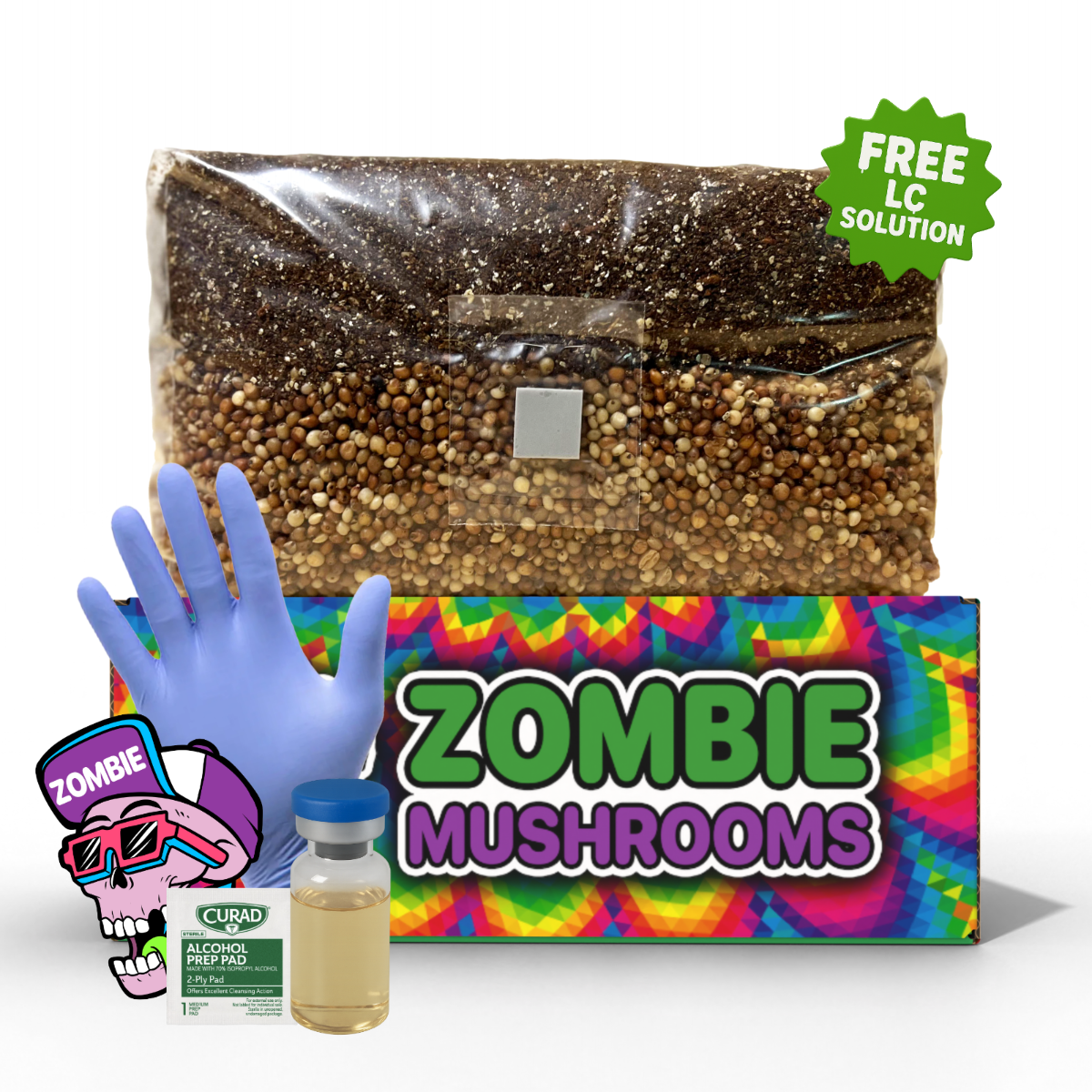⬇️ Prefer to listen instead? ⬇️

- Chaga is rich in melanin, antioxidants, and beta-glucans which encourage healthy, radiant skin.
- A 2013 study verified Chaga's high antioxidant capacity, lessening oxidative stress in skin cells.
- Chaga extract notably reduced inflammation markers like nitric oxide in immune cells.
- Antioxidants in Chaga may aid in preserving and stimulating the skin’s natural collagen production.
- Chaga's polysaccharides improve skin hydration by attracting and holding moisture.
Mushrooms are culinary staples and they are becoming a fast-growing trend in health and beauty routines, especially for their skin advantages. Among all mushroom types, Chaga is notable not only for its traditional medicinal use but also for its scientifically supported skin-improving qualities. Packed with potent compounds like antioxidants, melanin, and immune-supporting beta-glucans, Chaga mushroom could be a significant addition to your skincare strategy. Explore growing mushrooms at home with our grow bags, making it easy to cultivate fresh, healthy fungi without the hassle.
What Is Chaga Mushroom?
Chaga mushroom (Inonotus obliquus) is a slow-growing, nutrient-dense fungus typically found on birch trees in cold regions such as Russia, Siberia, Canada, Korea, and parts of northern Europe and the U.S. Often misidentified because of its rugged, burnt appearance, Chaga actually contains a store of bioactive compounds inside its dark outer crust and orange-tinted core.
For centuries, Chaga has been valued in indigenous and Eastern European medicine for its ability to address a variety of ailments, from stomach disorders to skin and inflammatory issues. In modern times, it has gained prominence as a superfood, with advantages being increasingly studied for immune support, anti-aging, and especially for skin-related concerns.

Chaga Mushroom Benefits for Skin
Chaga's effect on skin health is based in its biochemical density—offering a full set of compounds such as melanin, betulinic acid, polysaccharides, and antioxidants that support important skin functions. Let’s analyze how Chaga targets different skin issues.
Premature Aging and Fine Lines
Collagen loss, sun exposure, and oxidative stress are main factors in visible aging. Chaga contains antioxidants and anti-inflammatory agents that may postpone or even reverse signs of premature aging.
By neutralizing free radicals before they can harm skin DNA and break down collagen, Chaga minimizes the oxidative processes that lead to fine lines, wrinkles, and loss of firmness. The combined effect can be improved skin elasticity, better tone, and a more youthful look.
Acne and Inflammatory Skin Conditions
Acne, rosacea, eczema, and similar conditions often arise from chronic inflammation and imbalanced immune responses. Chaga can adjust these problems because of its high anti-inflammatory potential through compounds like betulinic acid, ergosterol peroxide, and inotodiol.
In particular, studies like those by Park et al. (2005) indicate that Chaga notably reduces inflammatory markers in immune cells, thus supporting its role in calming redness, swelling, and irritation caused by these skin conditions.
Environmental Stress and Skin Barrier Repair
Chaga also strengthens the skin’s ability to recover from environmental stressors like UV radiation, air pollution, and harsh weather. This is especially critical for people living in urban areas or exposed to a lot of sun.
The presence of melanin in Chaga contributes to this effect. Naturally occurring melanin in this mushroom may offer UV-absorbing properties, shielding the skin from damaging rays and impeding photoaging caused by sun exposure.

Chaga as an Antioxidant Powerhouse
One of the strongest features of Chaga is its unmatched antioxidant content. Antioxidants play a key role in neutralizing free radicals—unstable molecules responsible for cellular damage and accelerated aging — and Chaga is among the top-ranking mushrooms for antioxidant potency.
In a significant study by Petrovic et al. (2013), Chaga demonstrated one of the highest ORAC (Oxygen Radical Absorbance Capacity) values among medicinal mushrooms. This quantifies its ability to eliminate harmful oxidants before they damage skin structures.
A prime example of its antioxidant arsenal is superoxide dismutase (SOD), an enzyme that acts as a cellular defense mechanism and reduces oxidative injury, which translates to visibly younger and healthier skin. This makes the daily or regular use of Chaga a practical support strategy for people seeking long-term skin protection.

Anti-Inflammatory Advantages
Chaga’s unmatched anti-inflammatory profile makes it an excellent choice for people with sensitive, allergy-prone, or reactive skin. Chronic inflammation not only worsens existing skin problems like acne but also speeds up skin aging and weakens collagen production.
- Chaga inhibits pro-inflammatory cytokines and enzymes
- Reduces nitric oxide levels in immune cells (a marker for inflammation)
- Improves tolerance of external stressors (cold, sun, chemicals)
In skincare, this amounts to reduced outbreaks, less redness, and a calm, soothed complexion. Even if you don’t suffer from obvious inflammation, reducing subclinical inflammation can create a visible glow and smooth texture.

Stimulating Collagen for Firmer Skin
Collagen, the primary structural protein in skin, is responsible for its elasticity, firmness, and supple texture. However, with age, collagen breaks down faster than it’s produced, especially when exposed to UV radiation and oxidative stress.
The antioxidants in Chaga counteract some of these processes, indirectly supporting collagen regeneration. By fighting free radicals and reducing inflammation that degrades collagen, Chaga creates the right environment for your skin to maintain its firmness and elasticity.
Additionally, compounds like triterpenes and phenolic compounds in Chaga have shown potential in maintaining skin integrity and stimulating fibroblasts—the cells responsible for collagen production.

Chaga for Skin Pigmentation and Protection
What sets Chaga apart from other mushrooms is its high melanin concentration—the same pigment responsible for protecting human skin against UV damage. Melanin acts not only as a natural sunscreen but also eliminates free radicals and binds to potentially toxic metals, preventing their harmful effects.
While it’s not a standalone sunblock, chaga offers cumulative photoprotection
- Reduces visible sun damage and photoaging
- May improve uneven pigmentation or dark spots over time
- Fortifies melanocytes, improving skin tone resilience
When regularly ingested or used in skin treatments, it could help prevent pigmentation disorders related to sun exposure and aging.

Deep Hydration and Moisture Retention
Another underrated but essential aspect of chaga mushroom skin benefits is hydration. One of the leading causes of dull, tired-looking skin is trans-epidermal water loss—the evaporation of water from your skin into the air.
Chaga combats this with its naturally occurring polysaccharides, which act similarly to hyaluronic acid. These long-chain sugars effectively attract, bind, and hold moisture within skin layers.
Regular use of chaga—either through tea, supplements, or topical applications—can result in
- Improved skin plumpness
- Reduction in fine dehydration lines
- A visible increase in radiance and glow

Immune Health and Skin Connections
Skin health and immune health are connected. Your skin is a physical barrier as well as an immune organ—filled with cells that ward off pathogens, toxins, and bacteria. The beta-glucans in Chaga mushrooms act as immune system modulators.
Research by Wasser (2002) has shown how beta-glucans stimulate immune cells like macrophages and T-cells, improving the body’s ability to respond to infections, repair tissue, and reduce inflammation. All of these are critical for maintaining a strong, healthy skin barrier.
This means Chaga doesn’t just treat surface-level symptoms—it supports your skin from within.

How to Use Chaga for Maximum Skin Benefits
There are multiple ways to use Chaga mushroom benefits for skin, inside and out
Internal Methods
- Tea: Simmer dried chunks or powder for at least 1 hour to extract water-soluble components such as polysaccharides and phenols.
- Tinctures: These alcohol-based extracts capture fat-soluble compounds like triterpenes, supplying a more potent anti-inflammatory effect.
- Powders and capsules: Easily added to smoothies, golden milk, or taken with meals.
Topical Methods
- Face oils and serums: Infused with dual-extracted chaga extract for antioxidant and melanin support.
- Masks: Bland Chaga powder with honey and oat flour for soothing facial treatments.
- DIY toners: Homemade chaga tea can double as a skin toner (store in fridge for freshness).

DIY Chaga Skincare Recipes
Want to use chaga mushroom skin benefits without spending too much? Try these easy DIY treatments:
Chaga Tea Toner
- Brew chaga tea (1 hour minimum)
- Cool completely and strain
- Apply with a cotton pad after cleansing
Chaga Glow Oil
- Simmer Chaga powder in jojoba oil on the lowest possible heat for 1–3 hours
- Strain and bottle in amber container
- Use 2–3 drops morning or night
Moisturizing Chaga Mask
- 1 tsp chaga powder
- 1 tbsp raw honey
- 1 tsp oat flour or finely ground oats
- Mix well, apply for 15–20 min, and rinse

Potential Side Effects and Safety Considerations
Though chaga is generally safe, moderation and individualized usage are important
- Blood sugar: May lower levels—use caution with diabetes medications.
- Blood thinners: Contains natural anticoagulants—avoid high doses if on blood-thinning medications.
- Kidneys: High oxalate content may affect those prone to kidney stones if consumed excessively.
- Start slow: Always try small amounts first and consult your healthcare provider.

Chaga vs. Other Medicinal Mushrooms for Skin
Chaga isn't necessarily superior to other mushrooms, but its combination of UV defense and antioxidant load makes it unique.

Choosing High-Quality Chaga Products
What to look for
- Certified wild-harvested or organically grown
- Dual-extraction (both alcohol and water)
- Lab-tested for heavy metals and purity
- Freeze-drying or low-temperature processing
Brands like Zombie Mushrooms offer scientifically formulated extracts and grow kits that maximize the potency and bioavailability of chaga’s active compounds—ideal for daily wellness and skin health.
Final Take: Should You Use Chaga Mushroom for Skin?
If your skincare goals include glowing complexion, reduced inflammation, firmer skin, and fortified UV protection, incorporating Chaga into your regimen offers science-backed promise. While not a miracle cure, this forest fungus strengthens your skin’s resilience from both the inside and out, helping you age gracefully and glow naturally over time.
Make it part of a holistic self-care approach—pair with sun protection, clean diet, and hydration—and Chaga just might become your go-to beauty secret from the woods.



